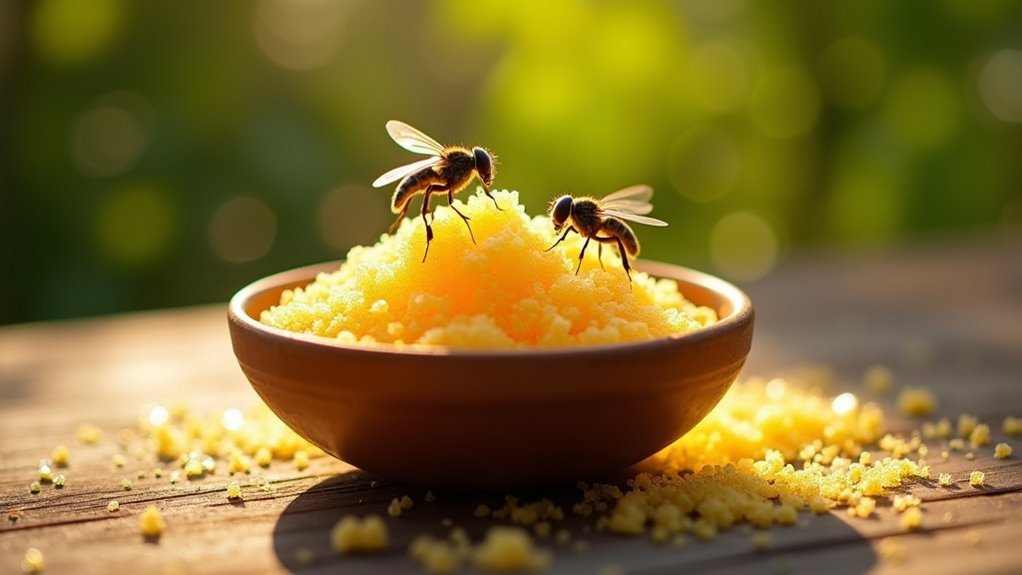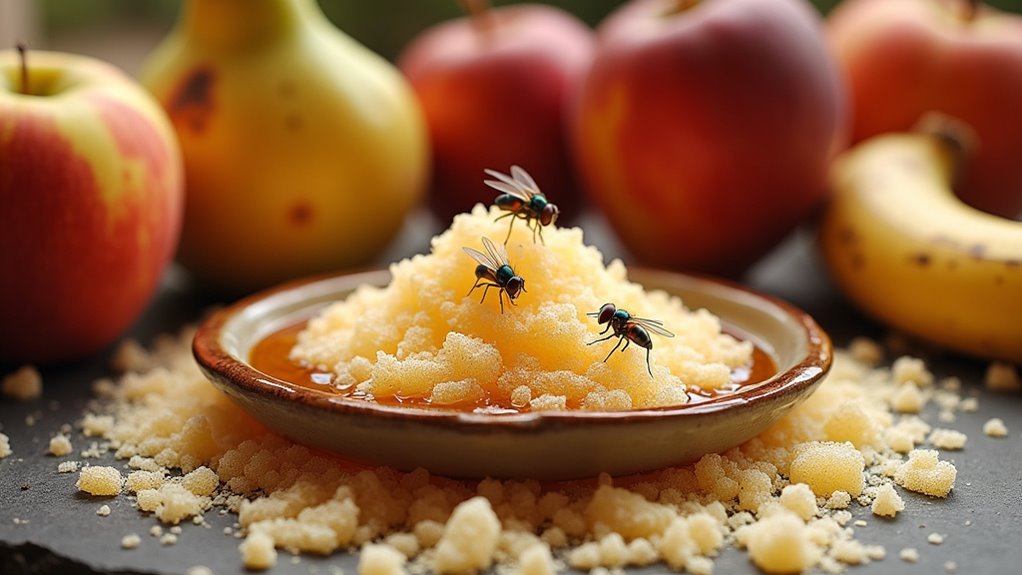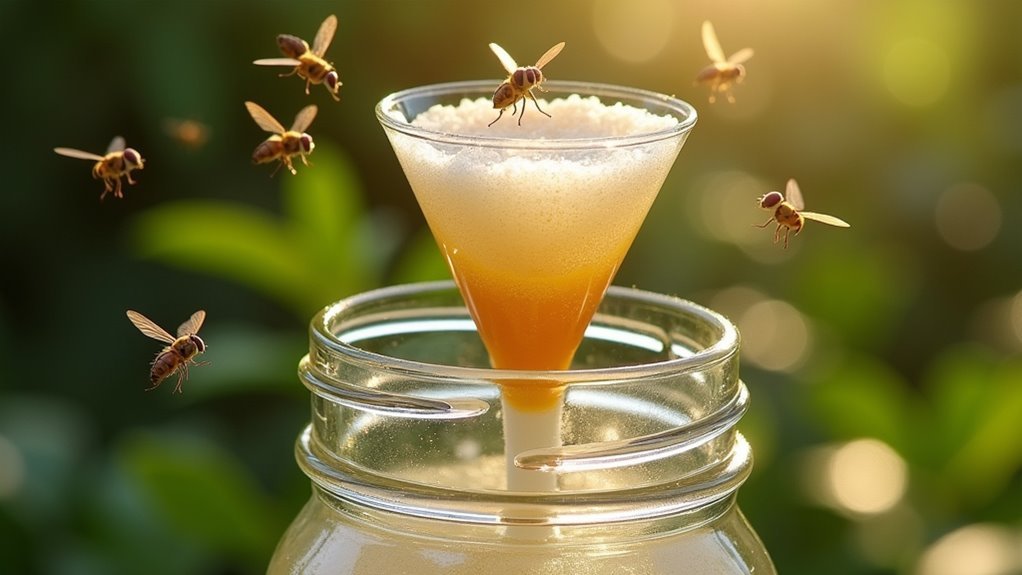You’re dealing with flies that can’t resist sugar because they’ve evolved specialized olfactory and gustatory receptors that detect sweet compounds from several meters away. Their antennae work like radar systems, picking up chemical trails in the air, while sugar provides the essential energy they need for survival and reproduction. These insects prefer concentrated sweetness over diluted solutions, making properly formulated sugar baits incredibly effective. The secrets to maximizing your trap’s success lie in understanding these biological mechanisms.
The Science Behind Fly Attraction to Sugar

When you observe flies swarming around sugary spills or rotting fruit, you’re witnessing millions of years of evolutionary programming at work. Flies possess specialized taste receptors designed specifically to detect sweet compounds, making them incredibly efficient at locating sugar-rich food sources.
This attraction isn’t coincidental—sugar serves as their primary energy source, fueling both survival and reproduction.
You’ll notice flies gravitate toward overripe fruits and decaying organic matter because these environments release volatile compounds that amplify their appeal.
Research consistently demonstrates that flies choose sugar solutions over non-sugar alternatives, proving this preference drives their foraging behavior.
Understanding this biological imperative explains why sugar-based baits work so effectively in pest control, exploiting their hardwired need for sweet substances.
How Flies Detect Sweet Substances From a Distance
You might wonder how flies can find your sugary snacks from across the room, but it’s their sophisticated chemical detection system at work.
Flies possess specialized olfactory receptors that act like tiny antennae, picking up sweet molecules floating through the air from several meters away.
These distance sensing mechanisms allow them to follow chemical trails directly to their target, making your sugar bait nearly irresistible once those sweet particles reach their receptors.
Chemical Receptors and Detection
Although you might assume flies stumble upon sugar baits by chance, these insects actually possess sophisticated chemoreceptors that function like biological radar systems, detecting sweet substances from remarkable distances. These specialized receptors work through integrated taste and smell pathways, creating a powerful detection network.
| Receptor Type | Function | Detection Range |
|---|---|---|
| Gustatory | Direct sugar identification | Contact required |
| Olfactory | Volatile compound sensing | Several meters |
Your sugar baits trigger multiple receptor systems simultaneously. Flies don’t just detect table sugar—they’re programmed to recognize glycerol from fermentation and various sweet compounds from decaying matter. Specific genes control this sugar-detection ability, making flies incredibly efficient foragers. When you set sugar baits, you’re fundamentally broadcasting a chemical signal that flies can’t ignore.
Distance Sensing Mechanisms
Flies’ antennae contain thousands of olfactory sensory neurons that transform them into extraordinarily sensitive chemical detectors, capable of picking up sugar molecules from distances that would seem impossible for such small insects.
You’ll notice flies can detect your sugar water from several meters away because their antennae work like sophisticated radar systems, constantly sampling air currents for sweet compounds.
These specialized receptors don’t just detect presence—they pinpoint direction and concentration gradients.
When you place sugar bait outside, flies follow invisible chemical trails through the air, moving from areas of lower concentration to higher concentration.
Their olfactory neurons fire rapidly when detecting sugars and glycerol, sending immediate signals to their brain that trigger increased activity and directional movement toward your bait.
Creating the Perfect Sugar-Based Fly Bait Recipe

When you’re ready to craft an effective sugar-based fly bait, start with equal parts sugar and water to create a syrupy solution that’ll attract both fruit flies and house flies.
You’ll boost effectiveness by adding a small amount of vinegar, since flies are drawn to sweet and fermented scents.
Next, incorporate a few drops of liquid dish soap to break surface tension—this prevents flies from escaping once they land on your bait.
For enhanced potency, blend overripe fruit into your sugar solution. The natural fermentation process releases additional attractants that draw more flies.
Don’t hesitate to experiment with different sugar types like brown sugar or honey to determine which formulation yields the best results for your specific fly problem.
Essential Ingredients for Maximum Fly Attraction
Since flies possess rapid metabolic rates that demand constant energy replenishment, sugar serves as your most powerful attractant ingredient.
Sugar acts as an irresistible lure because flies need constant energy to fuel their high-speed metabolism.
When creating effective fly bait, you’ll want to focus on sweet substances that mimic their natural food sources.
The most effective ingredients for maximum attraction include:
- Sweet liquids – Honey, syrup, and sugar water provide concentrated energy sources that flies can’t resist.
- Fermented beverages – Wine, beer, and fruit juices contain both sugar and glycerol compounds that enhance attraction.
- Fruit extracts and vinegars – Apple cider vinegar or fruit essences amplify the overall appeal when combined with sugar.
You’ll achieve ideal results by combining these ingredients rather than using them individually.
The fermentation process produces glycerol, which acts as an additional attractant beyond the sugar content alone.
Mason Jar Sugar Trap Construction Guide

Building an effective mason jar sugar trap requires just four basic materials and takes less than five minutes to complete. You’ll need a mason jar, lid, hammer, and nail to construct this simple device that’ll attract flies efficiently.
Start by using your hammer and nail to puncture small holes in the lid. These entry points allow flies to enter but make escape difficult. Secure the perforated lid back onto your jar.
| Bait Type | Effectiveness | Replacement Frequency |
|---|---|---|
| Apple cider vinegar | High | Weekly |
| Ripening fruit | Medium | Every 3-4 days |
| Honey | Medium-High | Weekly |
| Sugar water | Medium | Every 5 days |
Place your completed sugar trap near problem areas where flies congregate. Replace bait regularly to maintain maximum attraction power and guarantee continued effectiveness.
Plastic Bottle Sugar Trap Assembly
Plastic bottles offer an even simpler alternative to mason jars for creating effective fly traps.
You’ll need just an empty soda or water bottle to get started with this straightforward assembly process.
Cut your bottle in half, keeping the bottom section for holding bait. Fill this base with sugar mixed in water – this sweet combination proves irresistible to flies.
Position the top half upside down into the bottom, creating a funnel that lets flies enter easily but makes escape nearly impossible.
Here’s how to maximize effectiveness:
- Add apple cider vinegar as an alternative attractant
- Include dish soap drops to break surface tension
- Refresh bait regularly to maintain strong scent attraction
This simple design guarantees flies drown quickly upon landing in your sugar mixture.
Optimizing Bait Placement for Best Results
While assembling your sugar trap marks the first step toward fly control, strategic placement determines whether you’ll catch a few stray insects or eliminate entire populations.
Position traps near garbage bins, compost piles, and overripe fruit where flies are attracted to abundant food sources. Set bait at their flying level or slightly above for maximum appeal.
Deploy multiple traps across various locations to cover wider areas and increase catching potential. Place them in shaded, sheltered spots to prevent sunlight from degrading the bait and maintain the sweet scent that draws flies.
Regular bait replacement guarantees continued effectiveness, as stale sugar loses its potency. These strategic placement techniques transform your homemade trap from a simple container into an efficient fly elimination system.
Sugar Vs Other Sweet Attractants: Effectiveness Comparison
You’ll find that sugar isn’t always your best option when comparing sweet attractants for fly control.
Glycerol consistently outperforms regular sugar water in attracting flies, while molasses often beats synthetic sweeteners in field tests.
Fruit syrups typically show the highest performance rates, making them worth considering over traditional sugar baits.
Sugar Vs Glycerol Efficacy
Although sugar has long been considered the primary attractant for flies, recent research reveals that glycerol often outperforms traditional sugar-based baits in controlled laboratory settings.
You’ll find that glycerol’s effectiveness stems from its unique chemical properties produced during yeast fermentation, creating distinct sensory cues that flies can’t resist.
The comparative advantages of glycerol over sugar include:
- Stronger preference response – Flies consistently chose beer containing glycerol over sugar water in experiments.
- Specialized detection mechanism – A specific gene allows flies to detect glycerol, confirming its unique appeal.
- Enhanced bait formulation potential – Understanding glycerol’s efficacy can improve your pest control strategies.
This knowledge transforms how you’ll approach fly control, making glycerol-based baits potentially more effective than traditional sugar solutions.
Molasses Vs Synthetic Sweeteners
When comparing natural molasses to synthetic sweeteners as fly attractants, molasses consistently demonstrates superior effectiveness despite synthetic alternatives often containing higher concentrations of sweet compounds. You’ll find that blackstrap molasses contains complex organic compounds, including substituted phenolic compounds and volatile organic compounds like acetaldehyde, which synthetic sweeteners can’t replicate.
| Attractant Type | Key Compounds | Water Content | Stability |
|---|---|---|---|
| Blackstrap Molasses | Phenolic compounds, acetaldehyde | Low | High |
| Synthetic Sweeteners | Artificial sweet compounds | Variable | Moderate |
| Diluted Molasses | Natural sugars + sodium chloride | Moderate | High |
Molasses maintains low water content that prevents bacterial growth, ensuring lasting effectiveness. Research shows that even diluted molasses with sodium chloride performs comparably to pure molasses, suggesting synthetic sweeteners lack the complete chemical profile necessary for ideal fly attraction.
Fruit Syrup Performance Rates
While natural molasses excels against synthetic alternatives, fruit syrups demonstrate even more impressive performance metrics when you’re evaluating sugar-based attractants for fly control.
These specialized syrups consistently outperform honey and molasses in controlled experiments, delivering superior capture rates that make them standout choices for pest management.
What makes fruit syrups so effective comes down to three key advantages:
- Dual attraction mechanism – They combine high sugar content with volatile compounds that enhance olfactory appeal.
- Optimized composition – Sugar and fruit-derived flavors work synergistically to increase attraction likelihood.
- Enhanced compound profile – Specific fruit-derived compounds boost attractiveness beyond plain sugar solutions.
You’ll find that fruit syrups’ multi-layered approach to fly attraction creates a more compelling bait than single-component alternatives, resulting in measurably higher success rates.
Common Mistakes That Reduce Sugar Bait Success
Even experienced pest controllers can sabotage their sugar bait efforts through seemingly minor oversights.
You’re making a critical error if you’re diluting your sugar bait too much – flies crave concentrated sweetness that triggers strong olfactory responses.
Don’t let your bait go stale either; flies quickly lose interest in fermented mixtures that no longer emit appealing odors.
Temperature matters more than you might think. Warmer conditions boost sugar compound volatility, making your bait irresistible.
You’ll also sabotage success by using containers without proper airflow – sweet scents need to disperse effectively to attract flies from distance.
Finally, avoid placing sugar bait near garbage or decaying matter. These competing odors will mask your bait’s scent completely.
Maintaining and Refreshing Your Sugar Fly Traps
Once you’ve set up your sugar fly traps, consistent maintenance becomes the difference between catching dozens of flies versus hundreds.
Your sugar bait loses its appeal within days as it dries out and becomes stale, so you’ll need to renew it regularly to keep flies coming.
Fresh bait is everything – stale sugar mixtures repel more flies than they attract, making regular renewal essential for success.
Here’s your maintenance routine:
- Renew every 2-3 days – Replace old sugar bait with fresh mixture before it becomes ineffective
- Clean thoroughly – Remove dead flies and debris that deter new visitors from approaching
- Add dish soap – Include a few drops when renewing to reduce surface tension and drown flies faster
Store excess sugar bait in sealed containers to prevent contamination.
Keep your solution thick enough to remain attractive without being overly diluted.
Safety Considerations When Using Sugar-Based Fly Traps
When you’re setting up sugar-based fly traps, you’ll need to prioritize the safety of children and pets who might accidentally ingest the bait or get stuck to trap residues.
You should also be aware that some commercial sugar baits contain toxic additives that can harm both humans and animals upon contact or consumption.
Proper trap placement away from high-traffic areas and secure containment of all bait materials will help you avoid these safety risks while maintaining effective fly control.
Pet and Child Protection
While sugar-based fly traps offer an effective pest control solution, they can pose significant risks to pets and children if proper safety measures aren’t implemented.
Commercial sugar-based traps often contain toxic agents like acetamiprid, which can cause serious health issues even in small quantities.
To protect your household members, follow these essential safety practices:
- Strategic Placement – Position traps in high, inaccessible locations away from curious pets and children.
- Safe Ingredients – Create homemade versions using apple cider vinegar or honey instead of commercial toxic baits.
- Regular Monitoring – Check traps frequently to guarantee bait remains secure and inaccessible.
You’ll also want to educate family members about potential dangers and maintain vigilant supervision around trap areas to prevent accidental ingestion.
Toxic Ingredient Awareness
Although sugar-based fly traps provide effective pest control, you must understand the toxic ingredients they contain to protect your household from serious health risks. Developing toxic ingredient awareness starts with reading labels carefully before purchasing or using these products.
| Toxic Ingredient | Health Risk | Safety Measure |
|---|---|---|
| Acetamiprid | Neurological damage | Clear labeling required |
| Organophosphates | Respiratory issues | Proper ventilation needed |
| Pyrethroids | Skin irritation | Wear protective gloves |
You’ll need to follow manufacturer instructions regarding concentration levels to maintain effectiveness while ensuring safety. Store traps away from children and pets, as the attractive smell draws unintended victims. Replace traps regularly to prevent decomposition hazards, and dispose of used traps properly to avoid environmental contamination and continued exposure risks.
Proper Trap Placement
Strategic trap placement forms the foundation of safe and effective fly control in your home.
You’ll maximize effectiveness while protecting your family by positioning fly traps in undisturbed areas where flies congregate naturally. Avoid high-traffic zones to prevent accidental contact with toxic bait ingredients.
Consider these essential placement guidelines:
- Distance from living spaces – Position traps away from children’s play areas and pet zones to prevent accidental ingestion.
- Stable surfaces – Choose locations that won’t be bumped or knocked over, reducing spill risks.
- Strategic visibility – Place traps where you can easily monitor their condition without frequent disturbance.
Proper positioning guarantees your fly traps remain effective while minimizing safety risks.
You’ll create a protective barrier that targets flies without compromising your household’s well-being through thoughtful placement decisions.
Frequently Asked Questions
Why Are Flies Attracted to Sugar?
You’ll find flies drawn to sugar because it’s their high-energy fuel source. Your sugary foods trigger their taste receptors and release volatile compounds they can smell from far away, making detection effortless.
How Do You Keep Sugar Flies Away?
You’ll keep sugar flies away by sealing entry points, cleaning surfaces promptly, storing food in airtight containers, eliminating standing water, using natural repellents like peppermint oil, and setting homemade traps.
Does Sugar Attract House Flies?
Yes, sugar definitely attracts house flies. You’ll notice they’re drawn to sugar’s high-energy content, which provides essential nutrients for their survival and reproduction through specialized taste receptors.
Why Do Bugs Like Sugar so Much?
You’ll find bugs crave sugar because it’s pure energy they desperately need. Their short lifespans mean they can’t waste time on low-energy foods, so they’ve evolved specialized receptors to detect and pursue sugar.
In Summary
You’ve now mastered the science behind why sugar bait works so effectively for fly control. By understanding how flies detect sweetness, creating the right bait mixture, and avoiding common pitfalls, you’ll consistently catch more flies than with random attractants. Remember to refresh your traps regularly and prioritize safety around children and pets. With these proven techniques, you’ll maintain fly-free spaces using nothing more than simple sugar-based solutions that work every single time.





Leave a Reply